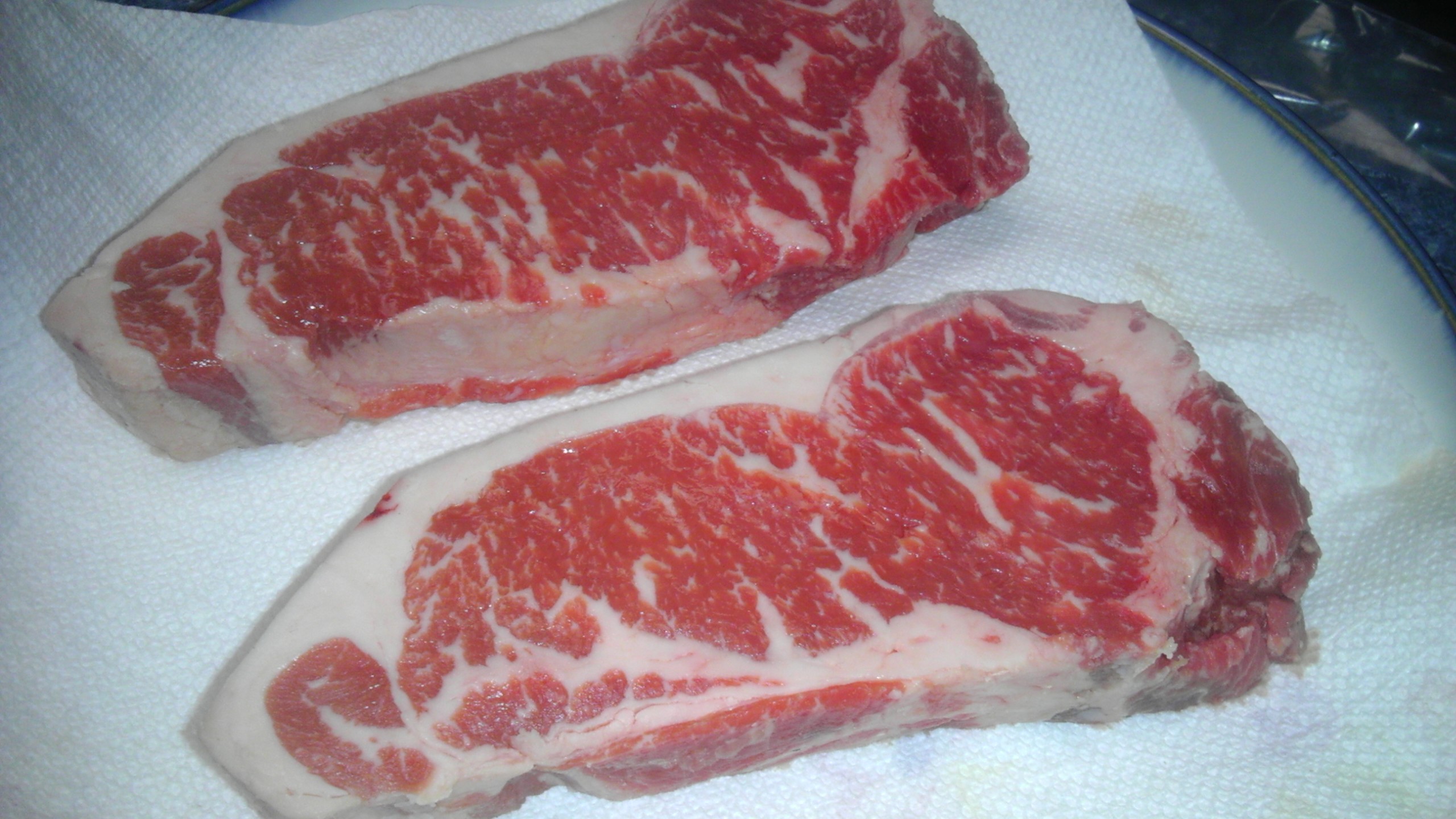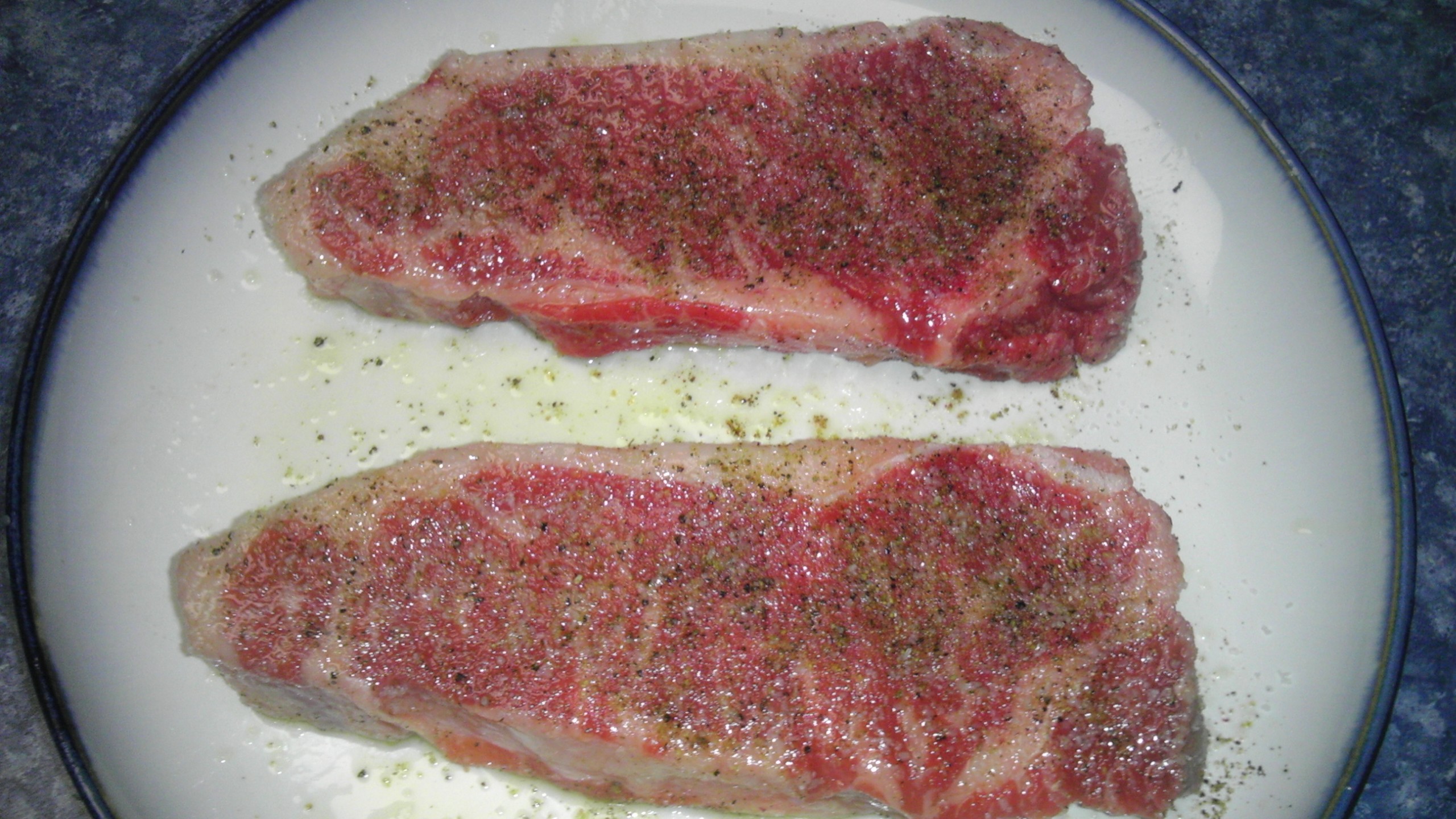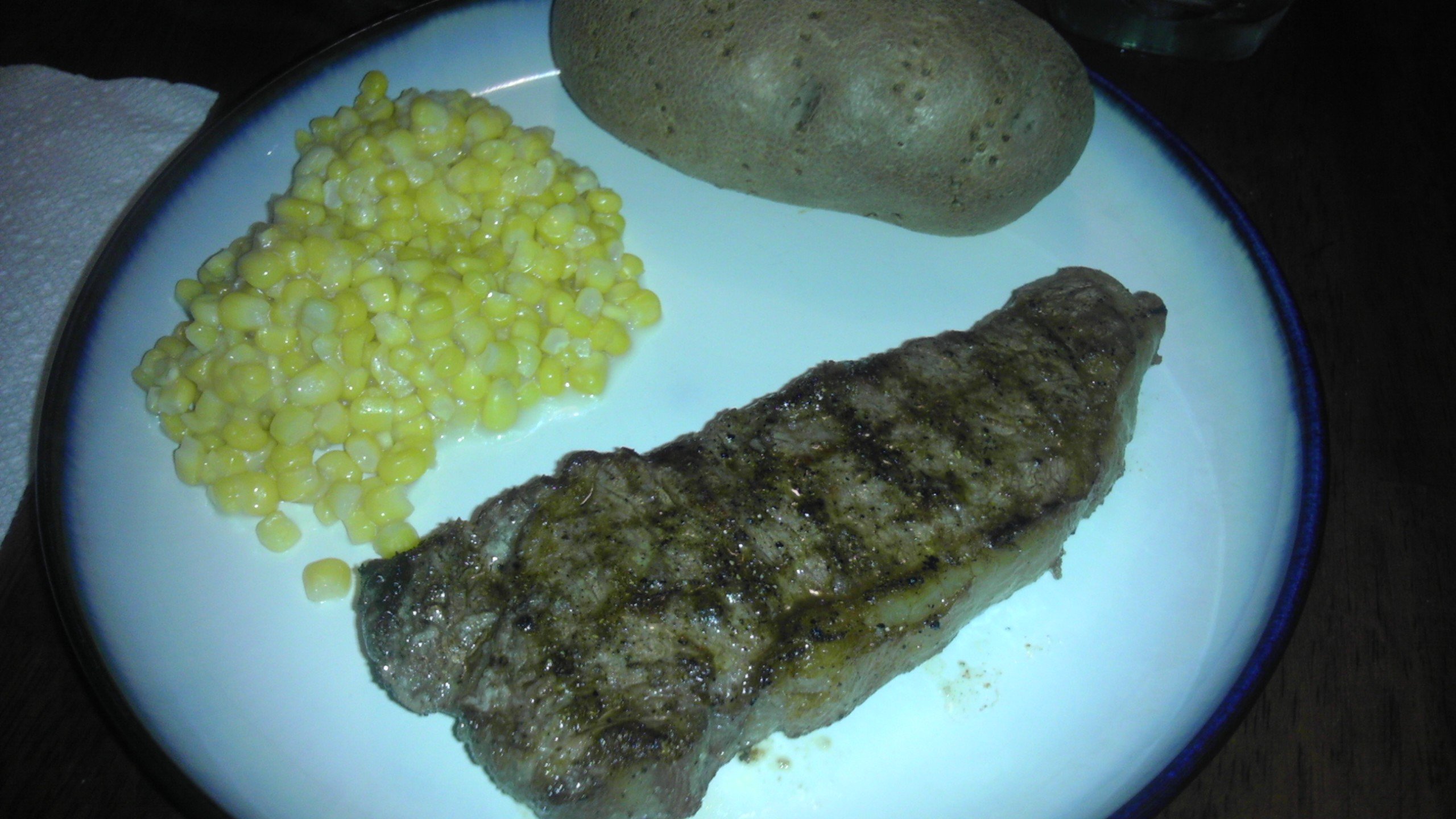Share your photos by tagging us and using the hashtag #BigGreenEgg.
Want to see how the EGG is made? Click to Watch
First Attempt at Steak
While I was at my local butcher shop this past weekend buying 16 pound of pork shoulder for Thursday, I decided to pick up a couple USDA Prime NY Strips. I have only owned my egg for a month now and have yet to attempt steak on it. After a bit of searching I decided to cook them up last night following TRex's Strip Steak Method. I knew I must have done something right when my wife told me that was one of the best steaks she has ever had in her life. These things were awesome! So incredibly juicy and tender.
Only thing I would do differently next time is check the temperature a minute or two sooner as they went a little higher (143°) than I was shooting for (130°-135°). I would also add slightly less salt as a couple of the bites were a bit on the salty side.
Here is the proof:

Olive oil, kosher salt, and freshly ground pepper

Finished product:

L-BGE | Lusby, MD
Comments
-
Nice. Beautiful marbling on them steaks.
Rowlett, Texas
Griffin's Grub or you can find me on Facebook
The Supreme Potentate, Sovereign Commander and Sultan of Wings
-
I am impressed. It took some cojones to go for Trex on your virgin steak cook with prime steak.:-bd
-
-
Great job- give the reverse sear a try too and see which one you all prefer. Cant go wrong with either-
Also depending on your appreciation for smoke taste you may want to toss in a couple chunks (and only a couple) of oak or mesquite or something else
Nice work on one of your first cooks!
Greensboro, NC -
Thanks for the complements. Beginner's luck I guess!
@Wolfpack I'll have to give reverse sear a try, but this is going to be hard to beat. I also did add a chunk of mesquite. I didn't really pick up that much of the flavor so I might add two chunks next time.
L-BGE | Lusby, MD
-
I find reverse sear a little easier and faster than Trex. I don't need the 20 minute rest in between the sear and roasting and it is a lot easier to get the egg up to temp rather than down. It is also easier to control the finish since you are 10-20 degrees away from finish prior to the sear. Then it's just 30-60 seconds per side.Both work very well. Especially on thick steaks. Do what you find most comfortable to provide the best results.
-
Eggcelsior said:I find reverse sear a little easier and faster than Trex. I don't need the 20 minute rest in between the sear and roasting and it is a lot easier to get the egg up to temp rather than down. It is also easier to control the finish since you are 10-20 degrees away from finish prior to the sear. Then it's just 30-60 seconds per side.Both work very well. Especially on thick steaks. Do what you find most comfortable to provide the best results.
Other than the advantages you spoke to, are there any advantages/disadvantages to the reverse sear method in regards to moisture retention? I am sure there are pages and pages on this subject already on the interwebs, do you know of any good resources that get down in the details of the pros/cons of the various methods?
L-BGE | Lusby, MD
-
I'm not a big fan of the reverse sear, because then internal temp of the meat determines how long you need to sear for. When you sear first and then bring it up to your finish temp, there's no timing involved. #1 in my book is always going to be the internal finish temp.QuackatthePrincipal said:Other than the advantages you spoke to, are there any advantages/disadvantages to the reverse sear method in regards to moisture retention?
Packerland, Wisconsin -
Great job. I messed up my first steaks bad thing T. rex. If its beginners luck lets hope it continues!"Sometimes you eat the bear and sometimes............. Well, he eats you"
-
http://www.amazingribs.com/recipes/beef/steakhouse_steaks.htmlThese 3 sites gave me the best information. Kenji Lopez-Alt worked at Cooks Illustrated and developed their reverse sear process. His Serious Eats page goes more in depth.ChokeOnSmoke is not wrong, but his reasoning does not apply to this situation. During Trex, you have to sear longer because the meat is still moist and cool when you apply the heat. The browning(maillard reaction) starts to occur at 310 degrees F. Even "allowing a steak to come to temp" on the counter for an hour will only cause a rise of maybe 20 degrees. The surface will never rise to the necessary temp for browning until evaporation of surface moisture occurs(212 degrees) Only then can it rise further. When you reverse sear, you are heating the meat up throughout, then searing. This gives you a short cut on the browning process which takes 30-60 seconds vs 90 second to 2 minutes. Both methods you take the steak off around 10 degrees below finish, so it is basically a wash. Either method works. I find reverse searing more consistent.There are many more things that go into cooking a steak which are explained on the pages I posted, from quality of meat to dry aging and salting. Reverse searing enhances the salting process as it moves faster with heat applied.The number one reason that I like reverse searing vs other methods is because I can get what consider a perfect steak every single time. To me, a perfect steak is medium rare with pink edge to edge and a nice crust. Other methods cause slight overcooking of the outer parts of the steak(banding) much more quickly than with reverse searing in my experience.All in all, it is personal preference. Have fun.
-
When searing on the CI grate on a Spider near the fire, do you stick in your Thermapen for doneness? Just curious to see if anyone is doing it right on the CI grate or whether you pull out the steak and then insert the Thermapen.LBGE & MiniOrlando, FL
-
@Eggcelsior Thank you for the excellent response! As an engineer, I love getting into the nitty-gritty details. I will definitely give reverse a shot.
L-BGE | Lusby, MD
-
-
Nice looking steaks! I like the reverse sear method too but I say experiment with both. Also, lose the olive oil....it adds nothing more than the risk of burned oil taste. Keep at it!Joe - I'm a reformed gasser-holic aka 4Runner Columbia, SC Wonderful BGE Resource Site: http://www.nakedwhiz.com/ceramicfaq.htm and http://www.nibblemethis.com/ and http://playingwithfireandsmoke.blogspot.com/2006/02/recipes.html
What am I drinking now? Woodford....neat -
Interesting facts in your write up, I've never considered the process in that detail. I think you may have convinced me to give the reverse sear another try.Eggcelsior said:ChokeOnSmoke is not wrong, but his reasoning does not apply to this situationPackerland, Wisconsin
Categories
- All Categories
- 182.7K EggHead Forum
- 15.7K Forum List
- 459 EGGtoberfest
- 1.9K Forum Feedback
- 10.3K Off Topic
- 2.2K EGG Table Forum
- 1 Rules & Disclaimer
- 9K Cookbook
- 12 Valentines Day
- 91 Holiday Recipes
- 223 Appetizers
- 516 Baking
- 2.4K Beef
- 88 Desserts
- 163 Lamb
- 2.4K Pork
- 1.5K Poultry
- 30 Salads and Dressings
- 320 Sauces, Rubs, Marinades
- 543 Seafood
- 175 Sides
- 121 Soups, Stews, Chilis
- 35 Vegetarian
- 100 Vegetables
- 313 Health
- 293 Weight Loss Forum






